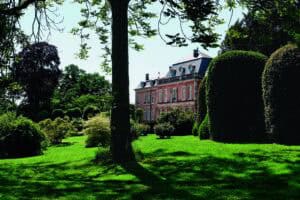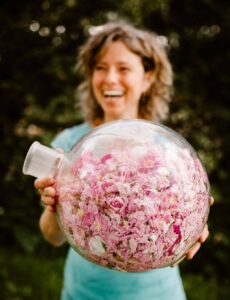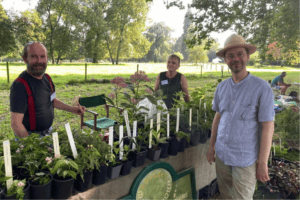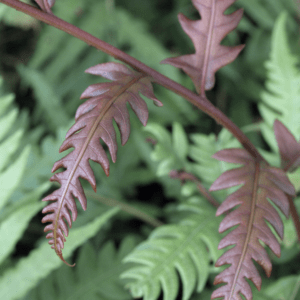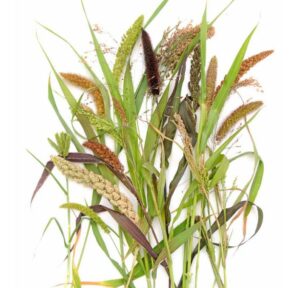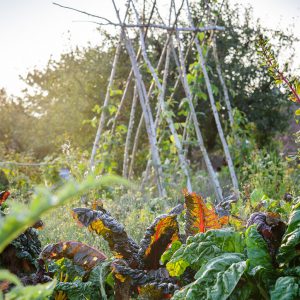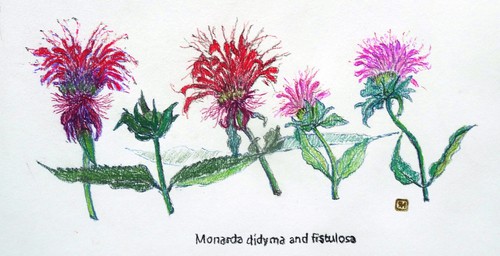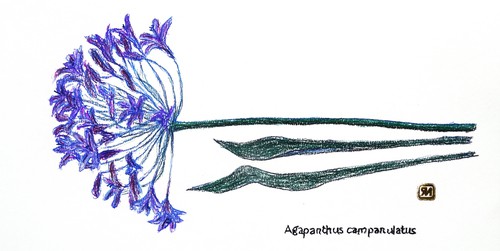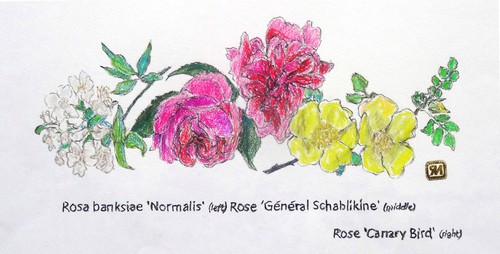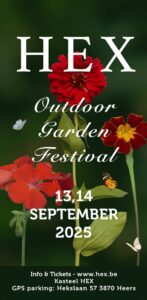The history of Hex has always been a story of roses: from the oldest rose varieties, which Prince-Bishop Velbrück had imported from China by the United East Indian Companies in the 18th century, to the collection of old and special roses that Countess Nanda d'Ursel collected to the latest creations from the world's most renowned rose breeders today. In the last half century, the rose collection of Hex castle has been continuously expanded. An estimated 1,400 roses are distributed in the gardens, of which about 500 are different varieties. The roses are present in formal beds and in the mixed borders, as large solitary plants, or grow over the fences, throw themselves over the balustrade and climb between the walls and the trees…
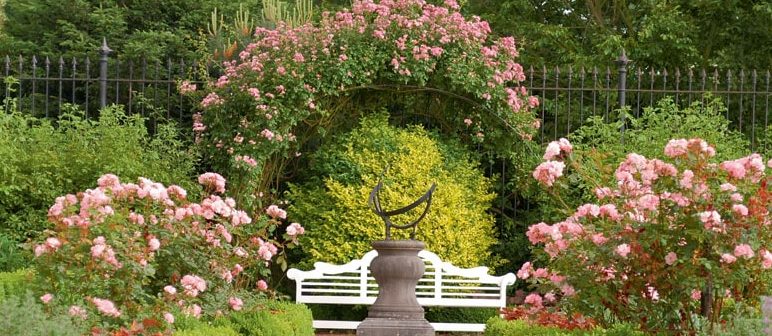
A WORK OF GENERATIONS
The mapping of the historic roses of Castle Hex was done with passionate attention and dedication by the late Countess Nanda d'Ursel. She made sketches and described the most special roses in detail in her garden diary. Later the Countess met Edith Dasnoy with whom she made watercolors of the most beautiful species. Together they published the book "Roses from the Gardens of Hex" (1995). The book is still for sale (during the garden days at the Hex stand).

A HISTORY OF ROSES
Wild roses come from the Northern Hemisphere, and span from the Arctic to Northern Africa, from the American Plains and New Mexico to Yemen, Thailand, South India and China. In Western Europe, species of Dog-Rose and Egelantier are native - about thirty species - but more than 200 wild rose species are known worldwide. On the flower meadow you will find the wild rose varieties that are characteristic of the flora of the Limburg and Brabant region.
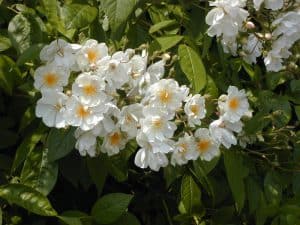
There are also numerous exoticplants throughout the gardens of Hex. There are a number of varieties of the Chinese Rosa banksiae near the fig garden and the varieties of the Scottish Rosa pimpinellifolia lined up behind the tennis court. Nearby you can also find the Rosa sericea pteracantha, with its striking winged thorns, which comes from Nepal. Rosa Mutabilis stands at the door of the vegetable cellar, and further away is Rosa roxburgii - both also imported from China. Here and there you can see climbers of botanical origin scrambling on the garden fences, against the walls or in the trees: Rosa arvensis, Rosa multiflora, Rosa filipes "Kiftsgate" and the impressive Paul's Hymalaian Musk at the front of the castle.
The botanical varieties with their wild clusters and their abundant flowering are almost unrivaled in charm and beauty. But thanks to the centuries-long culture of the rose, its exchange between the regions and the continents and the numerous crossings that this entailed, we now know an almost innumerable number of roses in all possible variations.
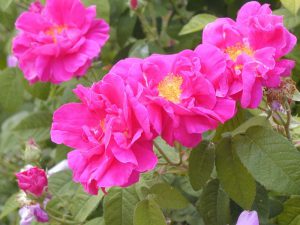 It is difficult to say when the Rosa gallica (French rose) was introduced to our regions for the first time. It occurs naturally in France and further east in southern Europe to Turkey. In its long history of culture, many variations of the French rose have emerged. They are all pink, flame red to deep violet, and they only flower once a year,
It is difficult to say when the Rosa gallica (French rose) was introduced to our regions for the first time. It occurs naturally in France and further east in southern Europe to Turkey. In its long history of culture, many variations of the French rose have emerged. They are all pink, flame red to deep violet, and they only flower once a year,
but they are very popular for their special perfume. In the gardens of Hex we see, besides the original wild form, some dozens of the most beautiful Gallica's collected, including Tricolor de Flandres, De la Maître d'École, Alain Blanchard, Charles de Mills and many others.
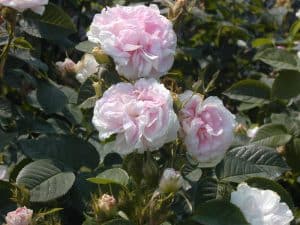 The white or soft pink Alba-rose was probably already cultivated by the Greeks and Ancient Romans. They come from a crossing between one of the Dog-roses with a Gallica rose, or possibly with a Damask rose. The growth habit of the Alba's is different from that of the Gallica's. They cast long flexible branches, which incidentally have few thorns. The leaves have a bluish appearance and the flowers smell sweet. The most beautiful examples, represented in Hex, are Celestial, Königin von Dänemark or Great Maiden's Blush (also once called "Cuisse de Nymph"). They only bloom once per year. The Albas, along with the Gallicas, are grouped together down in the vegetable garden, in the long border that extends alongside the sheep pasture, from the conservatory to the old well.
The white or soft pink Alba-rose was probably already cultivated by the Greeks and Ancient Romans. They come from a crossing between one of the Dog-roses with a Gallica rose, or possibly with a Damask rose. The growth habit of the Alba's is different from that of the Gallica's. They cast long flexible branches, which incidentally have few thorns. The leaves have a bluish appearance and the flowers smell sweet. The most beautiful examples, represented in Hex, are Celestial, Königin von Dänemark or Great Maiden's Blush (also once called "Cuisse de Nymph"). They only bloom once per year. The Albas, along with the Gallicas, are grouped together down in the vegetable garden, in the long border that extends alongside the sheep pasture, from the conservatory to the old well.
A third old family in the roses is the group of the Damask roses. They are crossings between the Rosa gallica with other wild species from the Mediterranean Sea area such as Rosa phoenicea or Rosa moschata. The Herst-Damask rose is special because it is the first one to have a second bloom in late summer. Damask roses are significantly less hardy than the Gallica's. They grow tall and throw loose bunches of sweet-smelling large flowers in red, white or pink.
The Centifola or Provencerose was only born in the 16th century from a crossing of a Herst-Damask with a Rosa Alba. The group was sterile for a long time and was propagated with cuttings, until the 19th century when a fertile species arose that could be further crossed. In addition to the original Centifolia we find Petite de Hollande and Pompon de Bourgogne in the garden of Hex. The rosebushes of the Centifolia family are characterized by their thick, filled flowers that are slightly closed - which is why they are also called Cabbage Rose in England. Other names for this rose are Dutch rose or Rose de Peintre, because of its success with the Dutch masters of the 17th century.
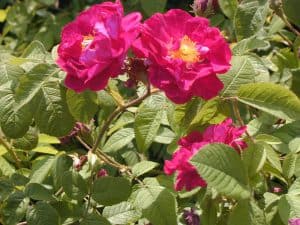 The Centifolia-Moss roses originated as a spontaneous deviation of normal Centifolia roses. The first is mentioned in 1720. The Centifolia moss rose is characterized by the presence of numerous scented gland hair on the flower stems. The growth method is somewhat striking, but that is compensated by the special character of the flower. The roses are very aromatic and the colors are deep violet or dramatically dark. Behind the double row of peonies in the vegetable garden are William Lob, Nuits de Young, Tuscany Superb and a dozen other exponents of this family.
The Centifolia-Moss roses originated as a spontaneous deviation of normal Centifolia roses. The first is mentioned in 1720. The Centifolia moss rose is characterized by the presence of numerous scented gland hair on the flower stems. The growth method is somewhat striking, but that is compensated by the special character of the flower. The roses are very aromatic and the colors are deep violet or dramatically dark. Behind the double row of peonies in the vegetable garden are William Lob, Nuits de Young, Tuscany Superb and a dozen other exponents of this family.
In China, roses have been grown for centuries and have been crossed into new cultivars. The first Chinese roses came to our region in the year 1792. The Rosa chinensis multipetala, which is still in the prinsenhof, is one of the first to be transported from China by the Dutch East India Company - according to tradition - at the special request of prince-bishop the Velbrück. In addition, you will also find Rosa indica rubra and an 'Old Blush' at the prinsenhof from that time.
On the island of Bourbon, an important mooring place for merchant ships - halfway on the route between Europe and the Far East, members of the Herst-Damask rose family met the Chinese rose (Rosa chinensis) in the 17th century. From the necessary crossings that followed, the Bourbon rose, which was later bred by crosses with Gallica and Damask hybrids. The family of the Bourbon roses has a good re-flowering in the late summer. The flowers are often half-filled and light-pink. In the garden of Hex you will find them mainly near the tennis court: Mme. Isaac Pereire, Louise Odier, La reine Victoria and others.
The Tea Box (Rosa odorata) is a Chinese rose that has long been in culture in China. She is called Tea Box because the flower smells slightly of tea. Intersections of the Tea Box with Noisette and Bourbon Roses yielded a whole new family of blooming Hybrid tea roses, which today is mainly known as a daisy. They are mainly in the beds in the conservatory in Hex.
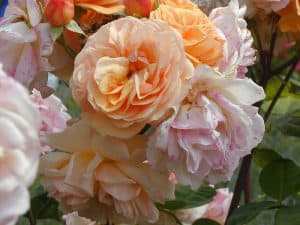 You can also find the roses from English rose grower David Austinclose to the conservatory. He has succeeded in uniting the best of two families.
You can also find the roses from English rose grower David Austinclose to the conservatory. He has succeeded in uniting the best of two families.
The romantic view and smell of the old Gallica's, Alba'a, Centifolia and Boubonros with the blooming character of the modern Tea hybrids.
Louis Lens, Belgian arborist and rose breeder, was a good friend of the late Countess Nanda d'Ursel. Lens took a completely new approach with growing roses for grasslands and public gardens. His Moschata hybrids have been sold all over the world. In Hex one can still find copies of his experiments, some of which have never reached the trade, for example in the row next to the caves. But you can also find some of his most beautiful creations in the vegetable garden and in the so-called friend garden next to the terraces.
Countess Nanda d'Ursel also had a weakness for the small bunches of roses Polyantha family. We find them in the vegetable garden in long rows in front of the peonies and in the beds around the water basin. The Polyanthas (or miniature roses) are descendants from complex crosses of Chinese roses with Centifolias, Bourbon roses or old Tea hybrids.
Finally, there is the Geschwind rosarium that was planted in 2012 by the old Cedar, at the back of the plane tree avenue. In addition to the famous "Gypsy Knabe", the collection contains several dozen unknown and forgotten rose varieties from Rudolf Geschwind from the beginning of the 20th century, collected from old gardens and the rosaries of Western and Eastern Europe. Geschwind roses are characterized by their natural character and resistance to all weather conditions. This rose collection is intended as a gene bank for future breeders.
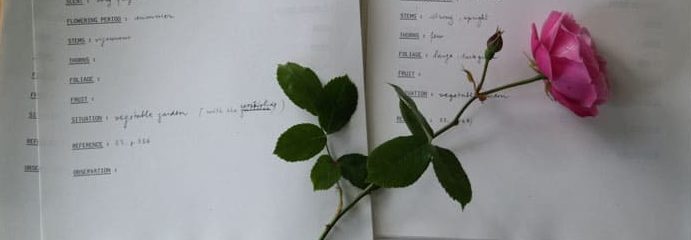
View here: the alphabetical register of roses from Hex.
NEW ROSE NAMES REFERRING TO HEX
Hex is particularly proud that in June 2013, due to the 20th anniversary of the Garden Days, a number of loyal exhibitors/breeders named new rose selections and winnings after Hex. They are:
- Rosa 'Gardens of Hex' - Lens Roses
- Rosa 'Kasteel Hex' - Peter Beales Roses
- Rosa 'Rebel of Hex' - De Bierkreek
- Rosa 'Spirit of Hex' - Vierländer Rosenhof
In 2016 a new rose was christened and named Countess Stéphanie d'Ursel, hostess and protectress of the historic gardens of castle Hex:
– Rosa 'Countess Stéphanie d'Ursel' - Lens Roses
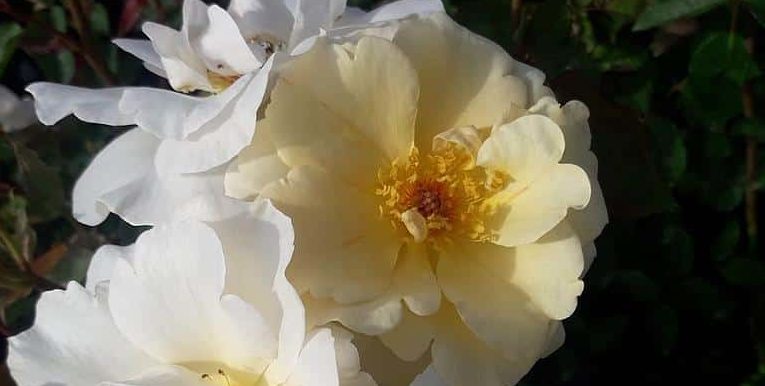
RECOMMENDED WEBSITES
Peter Beales – Lens Roses – De Bierkreek – Vierländer Rosenhof

